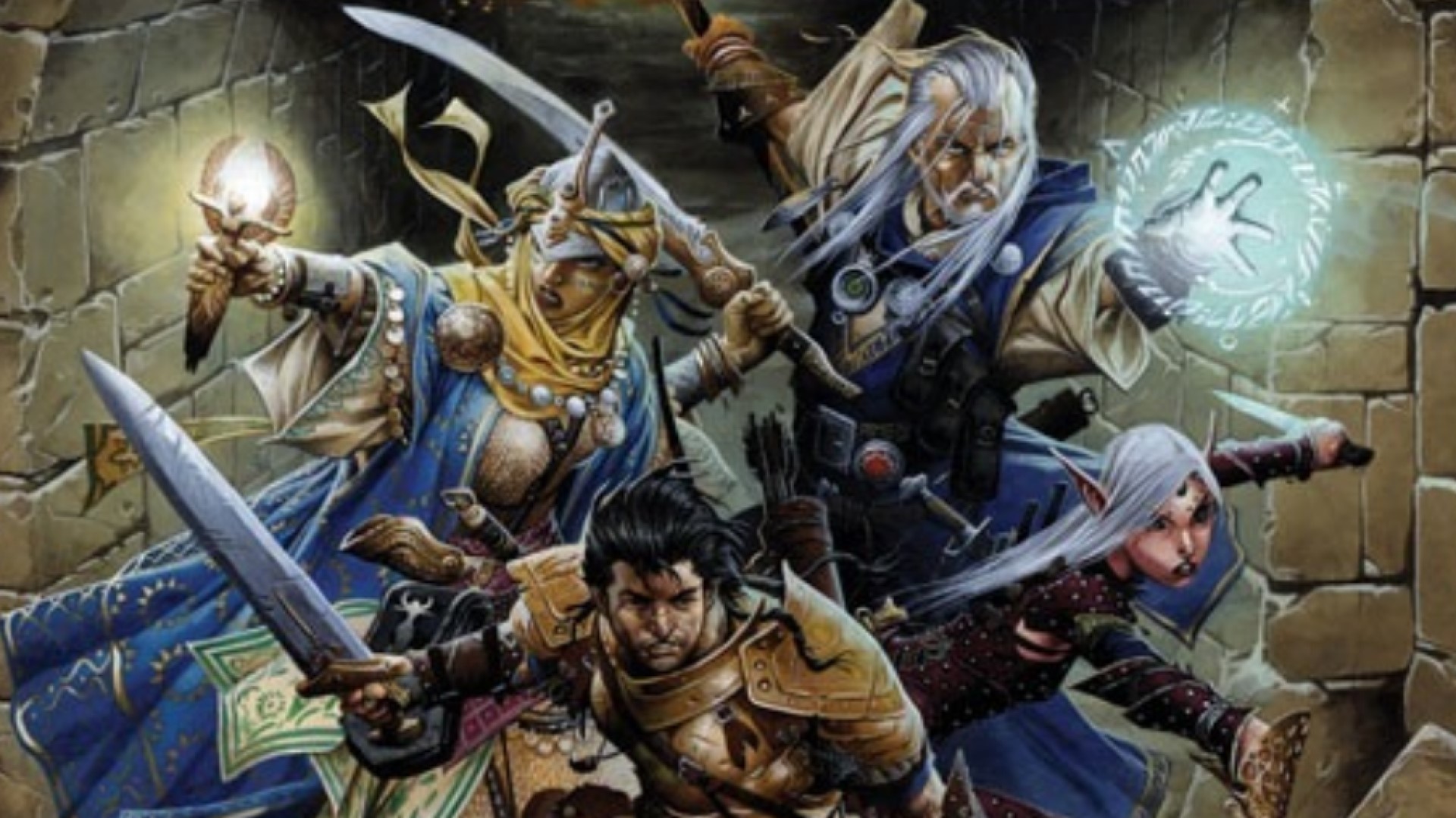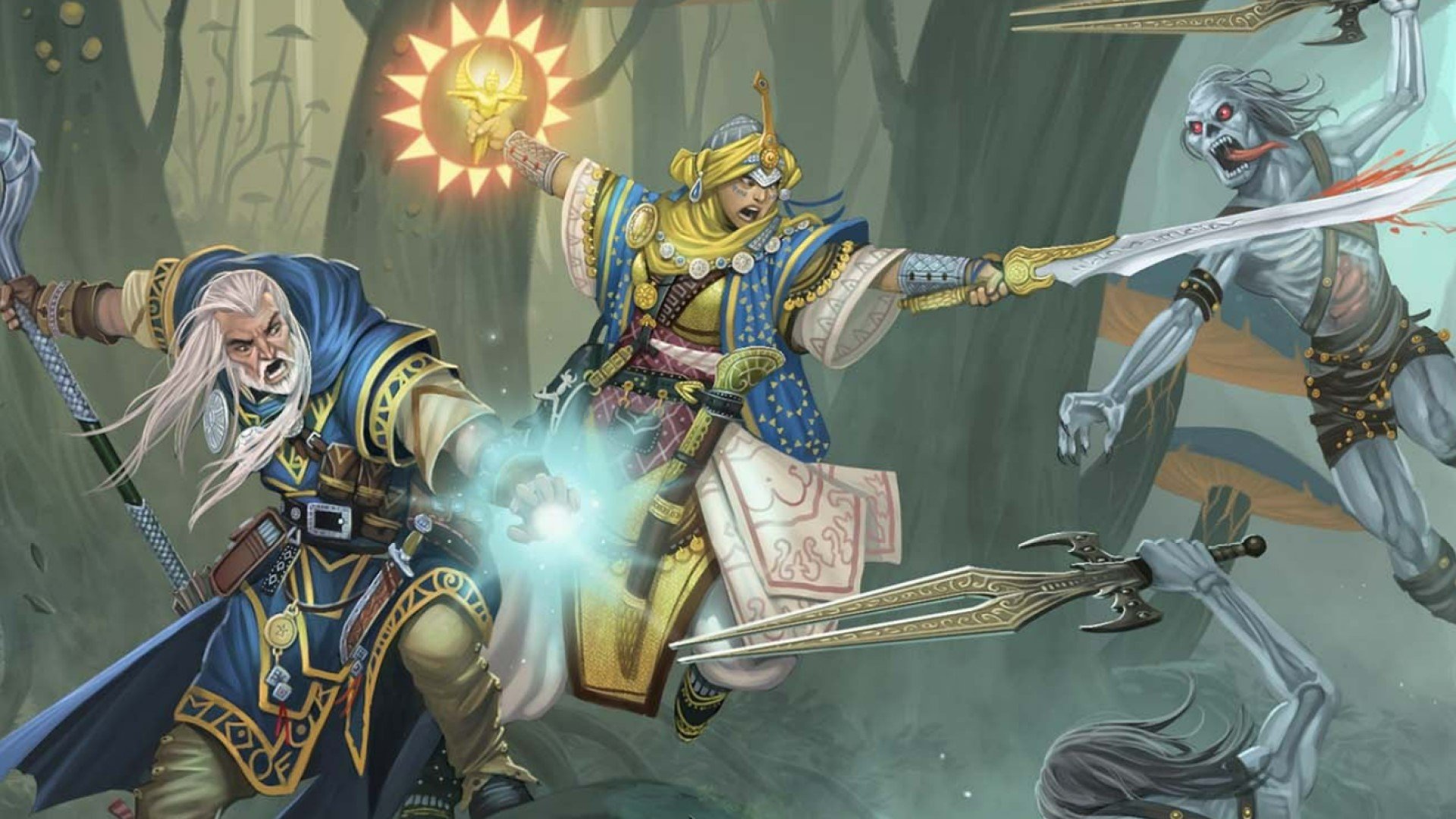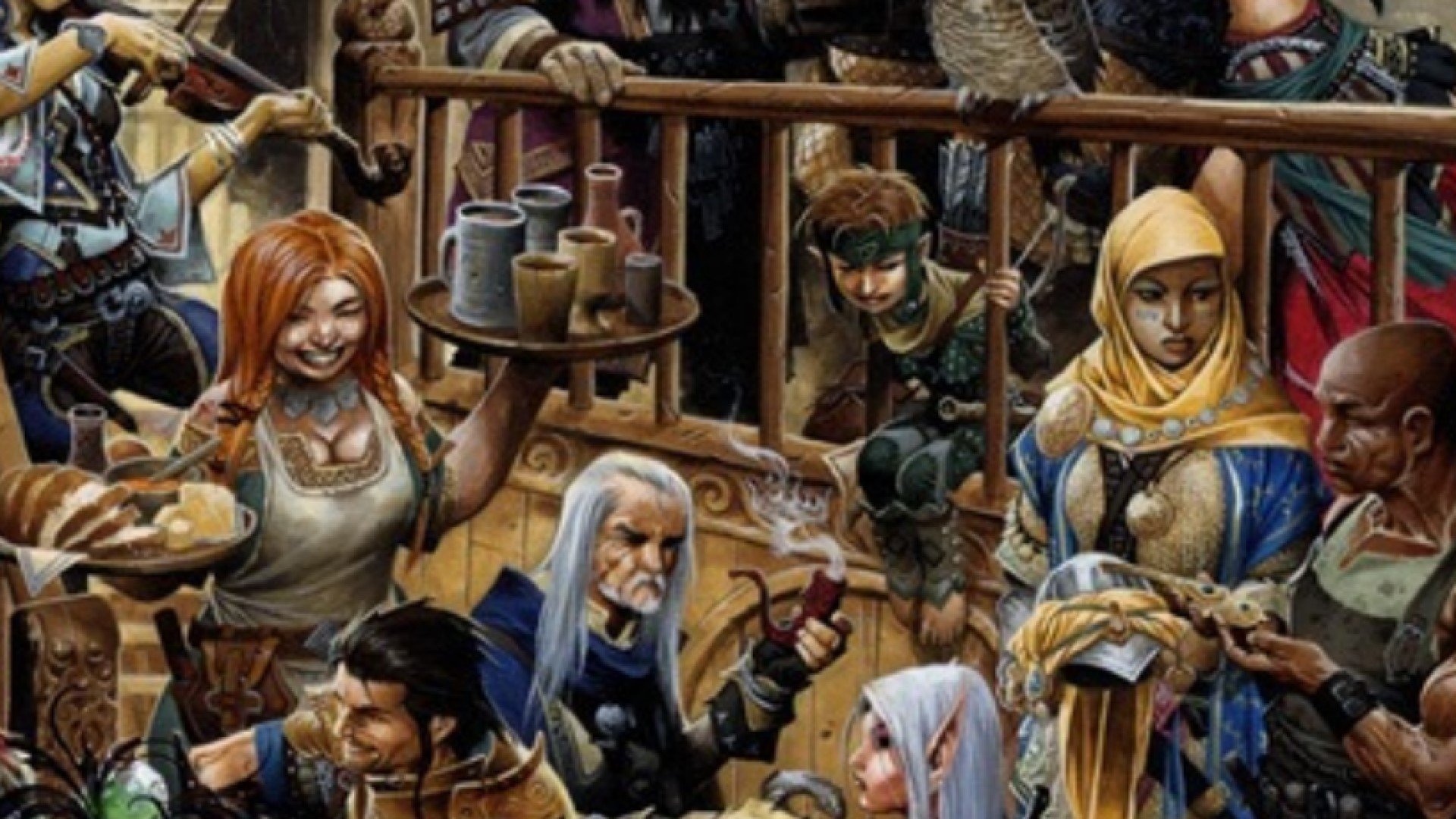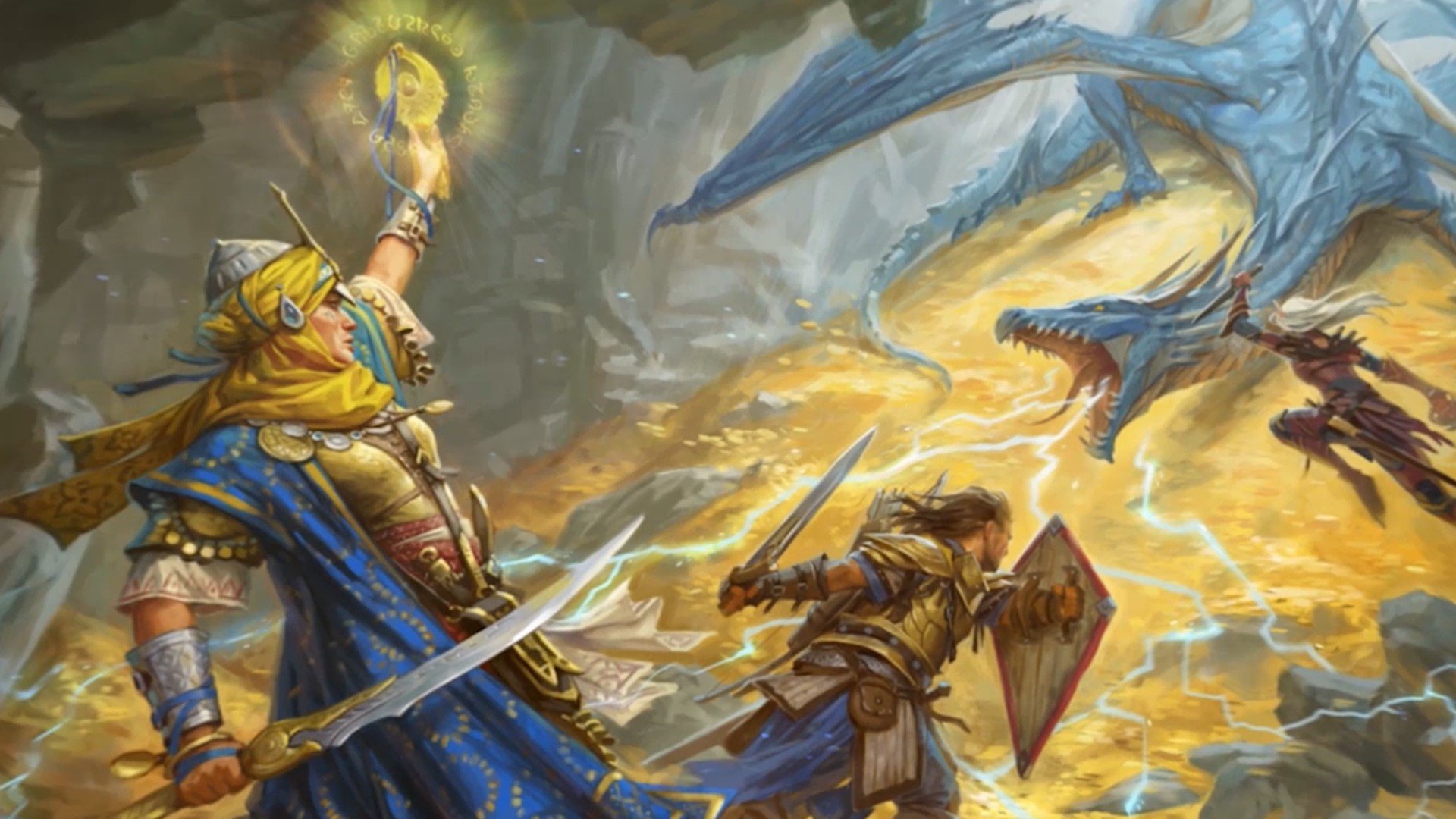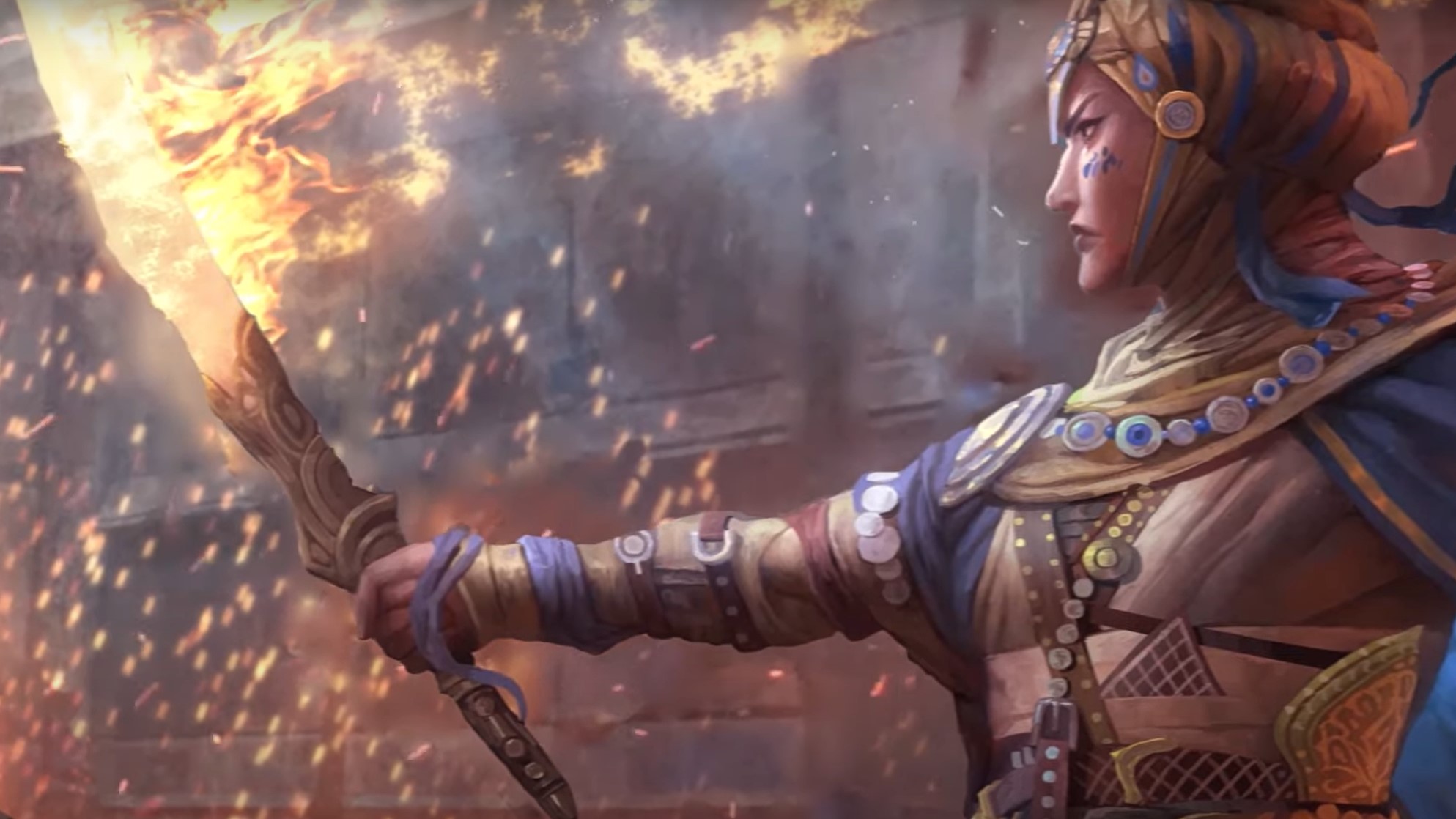The Pathfinder Cleric is imbued with the powers of the deity they dedicate their lives to serving. While some are more gifted with swords, all use spells to shape the world in their god’s name. Experienced Clerics are blessed with an immense amount of power, and it’s up to them whether they use this to heal or harm those around them.
Here you’ll find an overview of the Pathfinder 2e Cleric, the holiest of Pathfinder classes. We can help you fill out your Pathfinder character sheet with the right stats and features. After that, you can pick your perfect Pathfinder races, and get ready to play in a new campaign.
Here’s the full Pathfinder Cleric class guide:
- Pathfinder Cleric stats and proficiencies
- Pathfinder Cleric class features
- Pathfinder Cleric spells
- Pathfinder Cleric feats
Pathfinder Cleric stats and proficiencies
All Clerics get a first-level boost to their key ability score, Wisdom. Your starting hit points are eight plus your Constitution modifier, and this is the number you’ll use to increase your hit point maximum at level-ups.
Here are the proficiencies a Cleric has at level one:
| Type | Name | Rank |
| Skill | Perception | Trained |
| Skill | Religion | Trained |
| Saving throw | Fortitude | Trained |
| Saving throw | Reflex | Trained |
| Saving throw | Will | Expert |
| Attack | Simple weapons | Trained |
| Attack | Unarmed attacks | Trained |
| Defence | All armour | Untrained |
| Spells | Divine spell attacks | Trained |
| Spells | Divine spell difficulty checks | Trained |
The character can choose one extra skill to be trained in, with their deity narrowing down the options to pick from. Additionally, Clerics are trained in a number of skills equal to their Intelligence modifier plus two. You can choose any skill you like for those last few extras.
A Pathfinder deity might have a favoured weapon, and Clerics who worship them are trained to use their weapon of choice. If it’s an uncommon weapon, you also gain access to it. Typically, Clerics are untrained in all armour, but a deity’s doctrine may again switch this up a little. It all depends on the Cleric you’d like to build.
Pathfinder Cleric class features
Below you’ll find all the Cleric-specific class features a character can adopt as they level up. If you’re after the generic level-up features, the Pathfinder Core Rulebook can tell you more about general character progression.
| Level | Class features |
| 1 | Deity, Divine Spellcasting, Divine Font, Doctrine |
| 2 | Cleric feat |
| 3 | Second-level spells, second Doctrine |
| 4 | Cleric feat |
| 5 | Third-level spells, Alertness |
| 6 | Cleric feat |
| 7 | Fourth-level spells, third Doctrine |
| 8 | Cleric feat |
| 9 | Fifth-level spells, Resolve |
| 10 | Cleric feat |
| 11 | Sixth-level spells, fourth Doctrine, Lightning Reflexes |
| 12 | Cleric feat |
| 13 | Seventh-level spells, Divine Defence, Weapon Specialisation |
| 14 | Cleric feat |
| 15 | Eighth-level spells, fifth Doctrine |
| 16 | Cleric feat |
| 17 | Ninth-level spells |
| 18 | Cleric feat |
| 19 | Final Doctrine, Miraculous Spell |
| 20 | Cleric feat |
Deity
Level: One
There are plenty of gods to worship in Pathfinder, and Clerics must choose one particular deity to dedicate themselves to. As long as your alignment jives with that of your god, you’re good to become a Cleric in their service. However, you’ll need to make sure you stay in your god’s good books. Perform too many actions that go against the alignment or goals of a deity, and you might end up losing your magical connection with them.
Your deity will provide certain buffs, as well as proficiencies in a particular skill and weapon. They’ll also add spells to your Cleric spell list. These can be prepared like any other spell.
Divine Spellcasting
Level: One
This is your ability to cast Cleric spells. It means you can use the Cast a Spell activity, and Wisdom is your spellcasting modifier. You can prepare a certain number of spells and cantrips per day. While many of these require certain components to cast, a Cleric often uses a divine focus instead of material components.
Divine Font
Level: One
When preparing your spells, Divine Font gives you additional spell slots equal to your Charisma modifier plus one. These extra slots can only be used to prepare heal or harm spells. Which of these you choose will depend on what deity you worship; some may instruct you to use only heal or harm spells, while others may let you choose between the two. Whether you choose heal or harm, your choice can’t be changed without some dramatic personal or divine shift.
Doctrine
Level: One
Doctrines function a little like subclasses, and they represent different schools of belief among Clerics, even those who worship the same god. The Core Rulebook offers two potential Cleric doctrines: the Cloistered Cleric, who focuses on spellcasting, and the Warpriest, who invests more effort into martial combat options.
Cloistered Cleric features
| Level | Doctrine description |
| 1 | Gain Domain Initiate feat |
| 3 | Fortitude saving throw proficiency rank changes to expert |
| 7 | Divine spell attacks and difficulty checks proficiency change to expert |
| 11 | Attacks with your deity’s favoured weapon and unarmed attacks gain expert proficiency; critical successes on attack rolls with your deity’s favoured weapon apply its critical specialisation effect |
| 15 | Divine spell attack rolls and spell difficulty checks proficiency change to master |
| 19 | Divine spell attack rolls and spell difficulty checks proficiency increase to legendary |
Warpriest Cleric features
| Level | Doctrine description |
| 1 | Become trained in light and medium armour; Fortitude saving throws proficiency changes to expert; gain Shield Block feat; gain Deadly Simplicity feat if your deity’s preferred weapon is simple |
| 3 | Become trained in martial weapons |
| 7 | Unarmed attacks and attacks with your deity’s favoured weapon gain expert proficiency; apply your deity weapon’s critical specialisation effect on attack rolls that land a critical success |
| 11 | Divine spell attack rolls and spell difficulty checks proficiency increase to expert |
| 13 | If you gain the divine defence class feature, your proficiency in light and medium armour becomes expert |
| 15 | Fortitude saving throw proficiency rank becomes master, and all successful Fortitude save rolls are now critical successes |
| 19 | If you gain the divine defence class feature, your proficiency in light and medium armour becomes master |
Alertness
Level: Five
Clerics who gain Alertness as a feature see their Perception proficiency increase to expert level.
Resolve
Level: Nine
From now on, your proficiency in Will saving throws is at master level. You also roll a critical success every time you roll a successful Will saving throw.
Lightning Reflexes
Level: 11
Your Cleric’s proficiency in Reflex saving throws is now at expert level.
Divine Defence
Level: 13
Thanks to plenty of training and holy protection from your deity, your proficiency in unarmoured defence reaches expert level.
Weapon specialisation
Level: 13
When using unarmed attacks or a weapon you have expert proficiency in, you can now add two extra damage to successful hits. If your proficiency in the attack is at master level, you can add three damage instead, or four if the proficiency is legendary.
Miraculous spell
Level: 19
Miraculous spell grants you a single 10th-level spell slot. This is a precious resource, so there are extra rules for using it. Namely, you can’t use the spell slot on any ability that lets you cast a spell without expending a spell slot, or that gives you more spell slots.
Pathfinder Cleric spells
Here are the spell slots for a Cleric as they level up:
| Cleric level | Cantrips | 1st-level spells | 2nd-level spells | 3rd-level spells | 4th-level spells | 5th-level spells |
| 1 | 5 | 2* | – | – | – | – |
| 2 | 5 | 3* | – | – | – | – |
| 3 | 5 | 3 | 2* | – | – | – |
| 4 | 5 | 3 | 3* | – | – | – |
| 5 | 5 | 3 | 3 | 2* | – | – |
| 6 | 5 | 3 | 3 | 3* | – | – |
| 7 | 5 | 3 | 3 | 3 | 2* | – |
| 8 | 5 | 3 | 3 | 3 | 3* | – |
| 9 | 5 | 3 | 3 | 3 | 3 | 2* |
| 10 | 5 | 3 | 3 | 3 | 3 | 3* |
| 11 | 5 | 3 | 3 | 3 | 3 | 3 |
| 12 | 5 | 3 | 3 | 3 | 3 | 3 |
| 13 | 5 | 3 | 3 | 3 | 3 | 3 |
| 14 | 5 | 3 | 3 | 3 | 3 | 3 |
| 15 | 5 | 3 | 3 | 3 | 3 | 3 |
| 16 | 5 | 3 | 3 | 3 | 3 | 3 |
| 17 | 5 | 3 | 3 | 3 | 3 | 3 |
| 18 | 5 | 3 | 3 | 3 | 3 | 3 |
| 19 | 5 | 3 | 3 | 3 | 3 | 3 |
| 20 | 5 | 3 | 3 | 3 | 3 | 3 |
| Cleric level | 6th-level spells | 7th-level spells | 8th-level spells | 9th-level spells | 10th-level spells |
| 1 | – | – | – | – | – |
| 2 | – | – | – | – | – |
| 3 | – | – | – | – | – |
| 4 | – | – | – | – | – |
| 5 | – | – | – | – | – |
| 6 | – | – | – | – | – |
| 7 | – | – | – | – | – |
| 8 | – | – | – | – | – |
| 9 | – | – | – | – | – |
| 10 | – | – | – | – | – |
| 11 | *2 | – | – | – | – |
| 12 | *3 | – | – | – | – |
| 13 | 3 | *2 | – | – | – |
| 14 | 3 | *3 | – | – | – |
| 15 | 3 | 3 | *2 | – | – |
| 16 | 3 | 3 | *3 | – | – |
| 17 | 3 | 3 | 3 | *2 | – |
| 18 | 3 | 3 | 3 | *3 | – |
| 19 | 3 | 3 | 3 | 3 | 1** |
| 20 | 3 | 3 | 3 | 3 | 1** |
* See Divine Font for additional spell slots at this level
** See Divine Font for additional spell slots at this level; see Miraculous Spell for info on unique spell slot
Pathfinder Cleric feats
Here’s an overview of the Cleric feats available in Pathfinder 2e:
| Character level | Feats available |
| 1 | Deadly Simplicity, Domain Initiate, Harming Hands, Healing Hands, Holy Castigation, Reach Spell |
| 2 | Cantrip Expansion, Communal Healing, Emblazon Armament, Sap Life, Turn Undead, Versatile Font |
| 4 | Channel Smite, Command Undead, Directed Channel, Improved Communal Healing, Necrotic Infusion |
| 6 | Cast Down, Divine Weapon, Selective Energy, Steady Spellcasting |
| 8 | Advanced Domain, Align Armament, Channeled Succor, Cremate Undead, Emblazon Energy |
| 10 | Castigating Weapon, Heroic Recovery, Improved Command Undead, Replenishment of War |
| 12 | Defensive Recovery, Domain Focus, Emblazon Antimagic, Shared Replenishment |
| 14 | Deity’s Protection, Extend Armament Alignment, Fast Channel, Swift Banishment |
| 16 | External Bane, Eternal Blessing, Resurrectionist |
| 18 | Domain Wellspring, Echoing Channel, Improved Swift Banishment |
| 20 | Avatar’s Audience, Maker of Mircales, Metamagic Channel |

